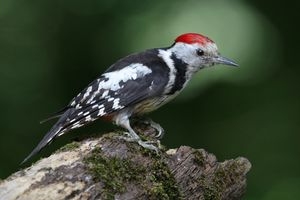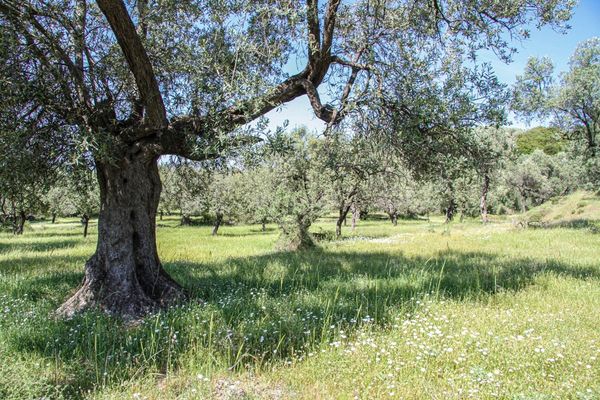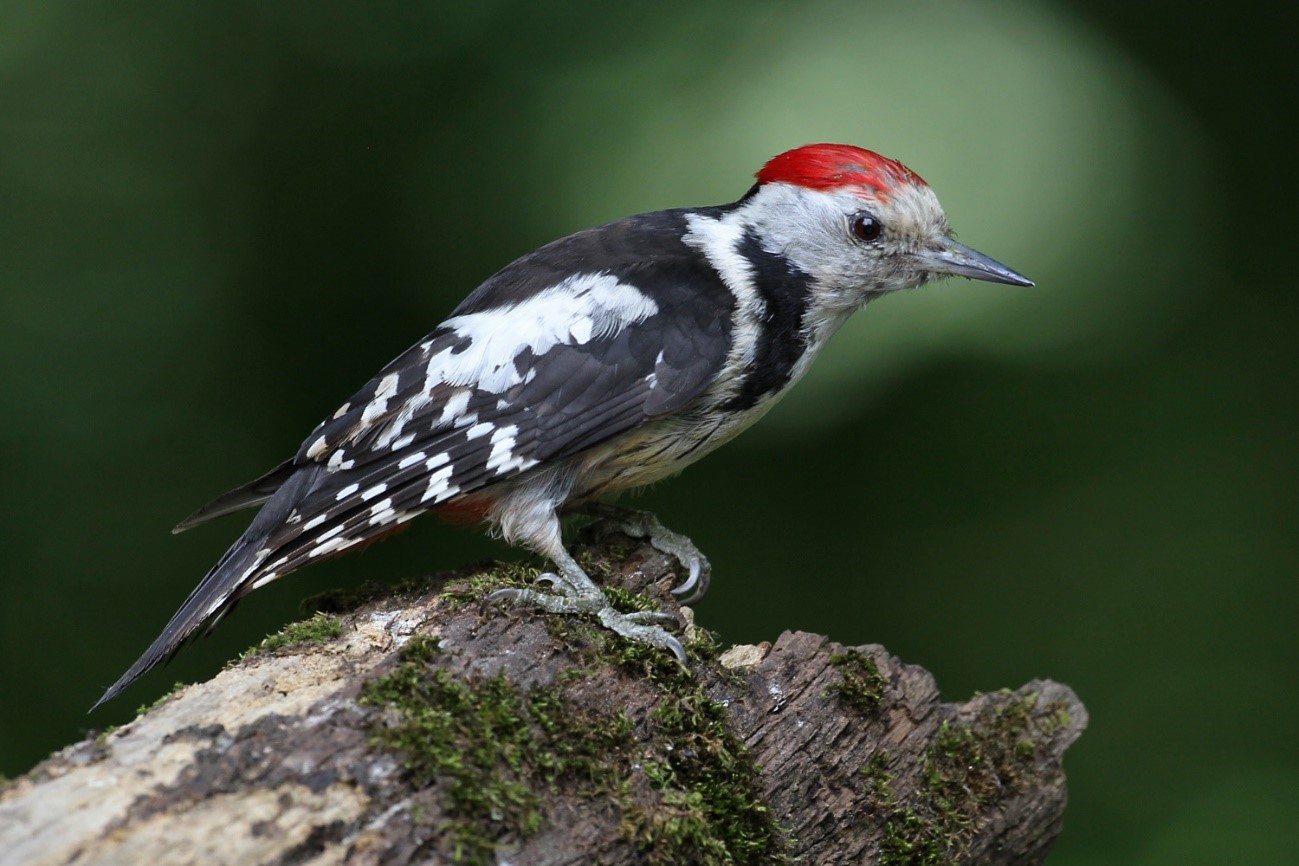 LINKED PAPER
LINKED PAPER
Deep genome‐wide phylogeographic structure indicates cryptic diversity in the Middle Spotted Woodpecker (Dendrocoptes medius). Schweizer, M., Tang, Q., Burri, R., Drovetski, S.V., Robles, H., Zyskowski, K., Aghayan, S., Rakovic, M. & Pasinelli, P. 2022 Ibis. doi: 10.1111/ibi.13054 VIEW
Birds are among the best studied organisms in terms of taxonomy and systematics. Nonetheless, several new species are described annually, and unexpected diversity can still be uncovered even in a European context. We report such as case in the Middle Spotted Woodpecker (Dendrocoptes medius) in a recent paper in Ibis.
This woodpecker species is a non-migratory, low-dispersal habitat specialist (Pasinelli 2003) that is morphologically rather uniform over its wide distribution area, which ranges from northern Spain over large parts of central and eastern Europe, the Balkans and Anatolia to the Caucasus, and an isolated area in the Zagros Mountains of Iran and Iraq (Robles & Pasinelli 2020, Winkler et al. 2020, Figure 2). Four subspecies are usually recognized showing only slight differences in size and plumage which are thought to be at least partly clinal (Vaurie 1959, Cramp 1985).

Figure 1 Top: distribution of the European (blue) and the Asian (red) lineages of the Middle Spotted Woodpecker. Circles indicate sample localities with colours corresponding to populations as shown in the principal components analysis (PCA) (bottom left) and sizes of the circles proportional to sample size. Bottom left: PCA of the different populations of the Middle Spotted Woodpecker; Asian (including the Caucasus) populations are clearly separate in the first axis from European populations. Bottom right: bar plots showing individual ancestry assignments with different colours based on admixture analyses using six populations. Assignment of individuals to the different populations as in the PCA is shown on the bottom of the figure. Signs for introgression form the Asian into the European lineage is indicated by the red and ochre colours in the bars of the individuals from Greece and Serbia.
We were thus more than surprised, when we found from a previous study a pronounced phylogeographic break between Asian (including the Caucasus) and European populations of the Middle Spotted Woodpecker based on data of mitochondrial DNA (Kamp et al. 2019). The divergence was at a level found between taxa sometimes treated as distinct species, for instance in the Green Woodpecker (Picus viridis) complex (Pons et al. 2011, 2019, del Hoyo & Collar 2014, Gill et al. 2022). Our result was all the more astonishing given the apparent lack of pronounced morphological differences between the Asian and European lineages and, given that the Marmara Sea, with the Dardanelles and Bosporus Straits separating the two lineages, should not represent a strong physical barrier for such a bird species.
The last decade has revealed many species with surprisingly deep phylogeographic structures in the mitochondrial DNA that are not reflected in morphological variation. However, phylogeographic structure inferred solely based on mtDNA might not represent the true evolutionary history of lineages for various reasons. Consequently, we wanted to test our unexpected finding with data stemming from the entire genome.
Our analyses based on 2,743 single nucleotide polymorphisms (SNPs) distributed throughout the genome revealed that the Middle Spotted Woodpecker might indeed comprise two morphologically cryptic lineages. Consistent with mitochondrial data, a clear genomic divergence between Asian (including the Caucasus) and European populations was revealed (Figure 2).
Despite the strong divergence, we found signatures of gene flow from the Asian into the European populations, suggesting at least limited introgression upon secondary contact. So far, the location of a such a putative secondary contact zone is not clear, nor is which prezygotic isolation factors other than demographic or geographical aspects could limit gene flow between the two lineages of the Middle Spotted Woodpecker. However, potential difference in vocalizations among the two lineages await to be studied and at least, slight differences in habitat preferences might exist. The Middle Spotted Woodpecker is mainly found in deciduous woodland dominated by oaks and avoids any other vegetation type on mainland Greece, but it is common in olive groves on the Island of Lesvos (Handrinos & Akriotis 1997, Figure 3). Olive groves are also inhabited on mainland Turkey, but oaks seem also to be a more important part of the species’ habitat there (Kirwan et al. 2008), so this might not be a straightforward case.

Figure 2 In contrast to European lineage, the Asian lineage of the Middle Spotted Woodpecker also inhabits Mediterranean vegetation such as olive groove, e.g. on Lesvos Island as shown here © Manuel Schweizer.
Our results definitely led to a better understanding of the phylogeographic structure of the Middle Spotted Woodpecker, but there are still several unclear issues remaining. For many, the following might be the most important: are there two species involved? Well, maybe – of course, also depending on the species concept applied. In any case, the amount of gene flow between the two evolutionary lineages of the Middle Spotted Woodpecker, and the potential processes and mechanisms that might restrict it, need to be investigated through more comprehensive geographical sampling especially focused in the area of the potential location of a secondary contact zone.
For me, however, the following question is the most important: When even well-studied European bird species can reveal such unexpected cryptic diversity, how many species still await to be discovered in comparatively understudied regions such as the tropics?
References
Cramp, S. 1985. The Birds of the Western Palearctic. Vol 4. Terns to Woodpeckers. Oxford: Oxford University Press.
del Hoyo, J. & Collar, N.J. 2014. HBW and BirdLife International Illustrated Checklist of the Birds of the World. Volume 1: No-Passerines. Barcelona: Lynx Edicions.
Gill, F.B., Donsker, D.E. & Rasmussen, P.C. (eds). 2022. IOC World Bird List (v 12.1). International Ornithologists’ Union. VIEW
Kamp, L., Pasinelli, G., Milanesi, P., Drovetski, S.V., Kosinski, Z., Kossenko, S., Robles, H. & Schweizer, M. 2019. Significant Asia–Europe divergence in the Middle Spotted Woodpecker (Aves, Picidae). Zoologica Scripta 48: 17-32. VIEW
Kirwan, G.M., Boyla, K., Castell, P., Demirci, B., Ozen, M., Welch, H. & Marlow, T. 2008. The Birds of Turkey: The Distribution, Taxonomy, and Breeding of Turkish Birds (G. M. Kirwan, ed). London: Christopher Helm.
Pasinelli, G. 2003. Dendrocopos medius Middle Spotted Woodpecker. Birds of the Western Palearctic Update 5: 49–99.
Pons, J.-M., Masson, C., Olioso, G. & Fuchs, J. 2019. Gene flow and genetic admixture across a secondary contact zone between two divergent lineages of the Eurasian green Woodpecker Picus viridis. Journal of Ornithology 160: 935-945. VIEW
Robles, H. & Pasinelli, G. 2020. Middle Spotted Woodpecker Leiopicus medius. In: Keller, V., Herrando, S., Vorisek, P., Franch, M., Kipson, M., Milanesi, P., Marti, D., Anton, M., Klvanova, A., Kalyakin, M.V., Bauer, H.G. & Foppe, R.P.B., (eds). European Breeding Bird Atlas 2 Distribution, abundance and change. Barcelona: European Bird Census Council (EBCC) & Lynx Edicions. VIEW
Vaurie, C. 1959. Systematic notes on Palearctic birds. No 35, Picidae: the genus Dendrocopos (Part 1). Am. Mus. Novit. 1946: 1–29.
Winkler, H., Christie, D., Kirwan, G.M. & de Juana, E. 2020. Middle spotted woodpecker Dendrocoptes medius. In Billerman, S.M., Keeney, B.K., Rodewald, P.G. & Schulenberg, T.S. (eds) Birds of the World. Ithaca, NY: Cornell Lab of Ornithology.
Image credit
Top right: Middle Spotted Woodpcker (Dendrocoptes medius) © Stefan Wassmer.
If you want to write about your research in #theBOUblog, then please see here.




